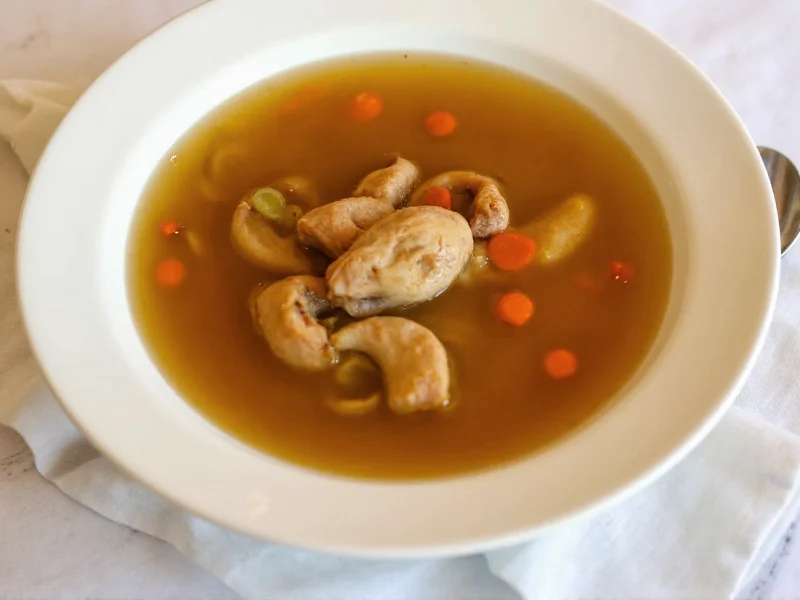Creating exceptional homemade chicken stock transforms ordinary soups into culinary masterpieces. Unlike store-bought versions, fresh stock provides unmatched depth of flavor and gelatin-rich texture that elevates any dish. Professional chefs and home cooks alike rely on this foundational ingredient for its versatility and nutritional benefits. The secret lies not just in the ingredients but in the technique—proper bone preparation, controlled simmering, and strategic flavor layering.
Essential Ingredients for Superior Chicken Stock
Quality ingredients form the backbone of exceptional chicken stock. While basic recipes exist, understanding ingredient roles helps you adapt based on availability without compromising results. Start with these core components:
| Ingredient | Quantity | Preparation Tip |
|---|---|---|
| Chicken bones | 2-3 lbs | Rinse thoroughly; roast at 400°F for 30 minutes for deeper flavor |
| Yellow onion | 1 large | Leave skin on for golden color; quarter without peeling |
| Carrots | 2 medium | Wash well; chop roughly (no need to peel) |
| Celery | 2 stalks | Include leaves for extra flavor |
| Garlic | 2 cloves | Smash with knife side for better flavor release |
Step-by-Step Chicken Stock Preparation
Follow these professional techniques for crystal-clear, flavorful stock every time. The process takes minimal active time but requires patience during the crucial simmering phase.
- Prepare bones: Roast chicken bones on a baking sheet at 400°F for 30 minutes until golden brown. This step develops complex flavors through the Maillard reaction.
- Build flavor foundation: In a 12-quart stockpot, combine roasted bones with vegetables, 1 tablespoon black peppercorns, and 1 bay leaf. Cover with 12 cups cold water.
- Initial boil: Bring to a gentle boil over medium-high heat, then immediately reduce to the lowest possible simmer. Never allow rapid boiling.
- Skim impurities: During the first 30 minutes, carefully remove foam and impurities that rise to the surface using a fine mesh skimmer.
- Simmer patiently: Maintain the barest simmer for 4-6 hours. Longer cooking extracts more collagen but risks cloudiness if temperature fluctuates.
- Strain properly: Line a colander with cheesecloth over a large bowl. Gently pour stock through without pressing solids.
- Chill correctly: Refrigerate uncovered for 12 hours to allow fat to solidify on top for easy removal.
Professional Techniques for Perfect Stock
Master these advanced methods to elevate your homemade chicken stock from good to exceptional. These techniques address common issues that plague beginner stock makers.
Cloudiness prevention: The primary cause of cloudy stock is vigorous boiling. Maintain a temperature just below simmering (180-190°F). Adding egg whites during simmering can clarify stock through protein coagulation—a technique called consommé preparation.
Flavor concentration: After initial straining, return stock to clean pot and reduce by one-third over medium heat. This intensifies flavor without artificial concentrates. Professional kitchens often freeze this concentrated stock as 'glace de volaille'.
Acid balance: Add 2 tablespoons apple cider vinegar during simmering. The mild acidity helps extract minerals from bones without affecting flavor. Don't worry—the vinegar taste disappears during cooking.
Variations for Specialized Culinary Applications
Tailor your chicken stock recipe to specific dishes with these professional adaptations. Each variation serves particular culinary purposes while maintaining the foundational technique.
- Cold-brew stock: For delicate consommés, combine ingredients in cold water and maintain 160°F for 8 hours. Produces exceptionally clear stock ideal for transparent soups.
- Herb-infused stock: Add fresh thyme, parsley stems, and a single rosemary sprig during the last hour of simmering for aromatic complexity without bitterness.
- Asian-inspired stock: Replace Western vegetables with 3-inch ginger slices, 4 scallions, and 1 star anise pod. Omit celery for authentic pho base.
- Quick weeknight stock: Pressure cook bones and vegetables with 8 cups water for 45 minutes at high pressure. Yields decent stock in under an hour when time constrained.
Proper Storage and Usage Guidelines
Understanding stock preservation techniques ensures your homemade chicken stock remains flavorful and safe. Proper storage methods significantly extend usability while maintaining quality.
After chilling and removing solidified fat, portion stock into:
- Ice cube trays for single-serving portions
- 1-cup containers for standard recipe measurements
- Vacuum-sealed bags flattened for space-efficient freezer storage
Label containers with date and type. Properly stored, homemade chicken stock maintains peak quality for:
- Refrigerator: 5 days
- Freezer: 6 months
- Pressure-canned: 1 year
When using frozen stock, thaw overnight in refrigerator or place sealed container in cool water. Never microwave frozen stock blocks as this creates uneven temperature zones that degrade quality.
Troubleshooting Common Stock Problems
Even experienced cooks encounter issues with homemade stock. These solutions address frequent problems while maintaining food safety standards.
Weak flavor: Reduce stock by half over medium heat. Add roasted mushroom trimmings during final hour for umami boost. Never compensate with salt alone—build flavor through proper technique.
Cloudy appearance: For immediate clarification, whisk one beaten egg white per quart into warm (not boiling) stock. Simmer 10 minutes, then strain through multiple cheesecloth layers.
Bitter notes: Caused by overcooked vegetables or burnt bones. Start new batch, being careful not to brown bones beyond golden stage. Add 1 teaspoon sugar to counteract mild bitterness in finished stock.
Excessive fat: Chill stock completely before skimming. The colder the temperature, the more fat solidifies for easier removal. For immediate use, place ice cube in warm stock—the fat will cling to the melting ice.











 浙公网安备
33010002000092号
浙公网安备
33010002000092号 浙B2-20120091-4
浙B2-20120091-4